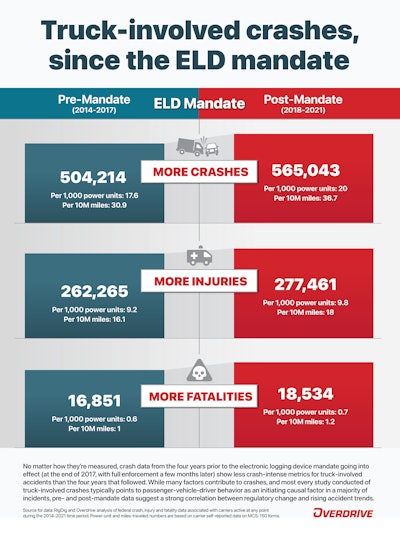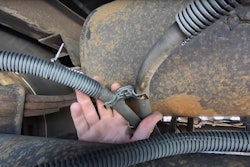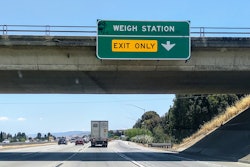When the electronic logging device mandate was finalized in December 2015, the Federal Motor Carrier Safety Administration estimated that the rule would save 26 lives and prevent 562 injuries on an annual basis.
Today, nearly five years since the mandate took effect for much of trucking in December 2017, truck-involved crashes resulting in injuries and fatalities have steadily gone up.
A recent analysis by Overdrive and sister business unit RigDig looked at crash and fatality/injury numbers in the four years prior to the ELD mandate (2014-'17) and the four years following initial implementation (2018-2021).
Crashes and fatalities/injuries numbers in the aggregate were generally flat from 2014 through 2017, rising and falling in small increments. Since the ELD mandate took effect in late 2017, however, crashes and injuries/fatalities have risen each year since but for 2020, when COVID-19-related shutdowns forced many passenger vehicle drivers to work from home and not commute, reducing highway congestion dramatically for much of the year.
Utilizing crash data from the Federal Motor Carrier Safety Administration's Motor Carrier Management and Information System (MCMIS), as well as authorized carriers' reported power-unit and miles estimates in FMCSA's system for each individual year, in the aggregate pre-and post-mandate, here's what the trend looks like comparing four years prior to and post-ELD mandate.

Given most crash-related trends point their way uphill post-ELD mandate, there is an obvious correlation between rising crashes, injuries and fatalities and the onset of the mandate.

When considered year-to-year, though, the various measures are up and down, depending on the timing and how rates are measured.
Both crash counts and those for fatalities/injuries involving trucks considered together were on the decline on a per-power-unit and per-mile basis from 2014 to 2015, yet patterns diverge somewhat in later years. Crash intensity per-reported-power-unit dropped in 2016, for instance, yet per-reported-mile it rose slightly the same year. (It should be re-emphasized: all crashes here are "truck-involved" and do not account for crash fault by any party.)
By and large, as shown below, though, crash rates from 2018 to 2021, in both metrics, are generally higher on average, as reflected for the entire four post-mandate years in the graphic above.
Injury/fatality numbers, considered together, paint a similarly mixed year-to-year picture. Measured per-reported-power-unit, the high-water mark for injuries/fatalities is the largely pre-mandate year of 2017 -- subsequent years, again but for 2020, saw more consistently-high rates than pre-mandate years, however.
As with patterns in the crash numbers, measured per-reported-mile, injury/fatality combined rates are more definitively up, again excepting the 2020 COVID year.
As for the question of what's causing the climb in crash-related trends post-mandate, most stakeholders in the business of trucking jump to answer with at least some kind of opinion, including FMCSA itself.
FMCSA downplays ELD mandate's significance in recent-years crash rise
In a recent interview with Overdrive, FMCSA Administrator Robin Hutcheson sought to downplay the influence on safety of any single regulatory measure, the ELD mandate included. She reiterated nonetheless the Department of Transportation’s National Roadway Safety Strategy that says zero is the only acceptable number of fatalities on roadways.
Regarding the ELD mandate, Hutcheson said it’s “always good to think about any individual measure in the whole suite of things that we do,” adding that there isn’t “going to be one thing that is the indicator of a curve of safety, whether it goes up or down. It’s everything, and it’s got to happen all at once.”
 FMCSA Administrator Robin Hutcheson
FMCSA Administrator Robin Hutcheson
FMCSA Associate Administrator for Policy Larry Minor recently noted the FMCSA had not yet begun its "Section 610" review of the ELD mandate, required by the Regulatory Flexibility Act for any rule of economic significance. Yet Hutcheson suggested the agency also sees the correlation between the start of the ELD mandate and the rise in crashes, injuries and fatalities. FMCSA is “interested really in looking at the underlying causes of why drivers become unsafe, and that goes beyond any sort of logging device,” Hutcheson said. “That goes straight to the work, some of the structures that drivers are working within.”
[Related: The COVID HOS waiver: Has 'self-regulation' equated to better safety?]
She believed that there “isn’t one factor" on which "you can place an increase or a decrease” in crashes and fatalities, and that there is “always a set of factors.”
Plenty owner-operators beg to differ, to an extent, with an overwhelming number of poll respondents among Overdrive's audience indicating a negative impact for highway safety as a result of the mandate and the ticking-clock pressures it added to an hours of service rule already problematic with regard to on-highway realities.
As Missouri-headquartered, Landstar-leased owner-operator John Highley put it recently, “You can’t put a stopwatch on a driver. Any time that you’re doing a [safety-sensitive] job, and you’re being timed to do that job, to a certain level, you’re going to start rushing that job. And I don’t know anybody that doesn’t do a job, get in a hurry, and mess the job up.”
A study released just last week by the American Transportation Research Institute, though, seemed to underscore the view of FMCSA Administrator Hutcheson. It examined which driver behaviors -- represented by violations, convictions, and crashes -- most closely correlate to future crash involvement. While the research was not designed to link correlations or causation between the ELD mandate and fatigue-related crashes, it did call into question whether there was any relationship between the two at all.
ATRI’s report cited a 2019 study by the Eli Broad College of Business at Michigan State University and the Sam M. Walton College of Business at the University of Arkansas, which looked at the effect of the ELD mandate on other driving behaviors. That study found that the ELD mandate reduced truck operators’ likelihood of violating hours-of-service regulations but also found that smaller trucking companies, which had low rates of ELD adoption before the mandate, “saw a significant uptick in their citations for unsafe driving behaviors,” including speeding, failing to obey traffic signals, following too closely, and improper lane change.
While giving weight to behavioral changes the mandate produced, the study found, too, that fleets of all sizes saw increases in their crash rates once enforcement of the ELD mandate started, suggesting other factors at play.
[Related: Study: Trucking accidents up after ELD mandate]
The Commercial Vehicle Safety Alliance, the standards-setting organization of state/local law enforcement jurisdictions and industry partners, sought to pin rising crash rates on behavioral shifts, too.
“The only thing that we can point to and see," said CVSA Executive Director Collin Mooney, "is that it really boils down to driver behavior.”
He said that ever since COVID, and a corresponding decrease in roadside enforcement, safety-adverse behaviors have gotten worse.
“Highways were wide open, and the only thing moving was truck traffic to keep trade and commerce moving,” Mooney said. “We saw that bad driving behavior only increased, because law enforcement officials weren’t stopping and inspecting as much as they [had been], obviously because of the transmission of COVID.”
Yet as the charts above show, with fewer cars on the highways, 2020 was among the safest years of the last eight Overdrive analyzed. Crashes fell to 1.81 per 100 trucks and 3.43 per 10 million miles, while injuries and fatalities fell to 0.93 per 100 trucks and 1.76 per 10 million miles -- better than any of the pre-mandate years except for 2016.
Nonetheless, Mooney stressed that unsafe behaviors had “really taken off during COVID, and it really hasn’t subsided since. We really need to figure out ways to address the driver behavior issue on our roadways.”
[Related: A sharp rise in moving violations, as inspection numbers inch back toward pre-COVID levels]
Mooney said that while the numbers “may give the appearance that it’s all related to the ELD mandate,” CVSA believed otherwise.
“It’s unfortunate that COVID happened right at the onset" of ELDs, he said, though initial implementation in December 2017 was more than two years ahead of the early-2020 COVID lockdowns. “The two are, in my opinion, unrelated, and we’re trying to make sense of all of the data currently in play. I just think that people are not driving and operating a commercial motor vehicle as smart as they used to. There’s a lot of distracted driving with smartphones and such. I do not believe it’s because of the ELD.”
FMCSA's Hutcheson emphasized a similar view, noting that “what we’re starting to see in the data is that crashes went up for a whole lot of reasons, some of which we don’t know everything about yet,” she said. “We have to look at a broad set of data for us to have any ... fidelity in our interpretation of a crash curve that may be going up or going down.”
Hutcheson noted, however, that the agency is always reviewing its rules and regulations, “but they have to be taken in context with a safe system and a holistic approach.”
Read next: The view from the road: ELD mandate increases pressure on operators, in more ways than one








